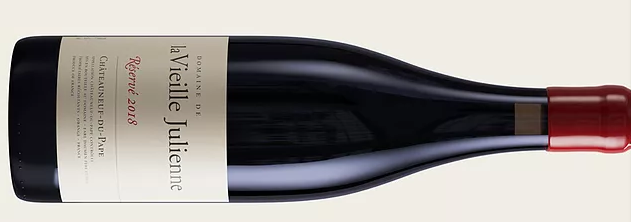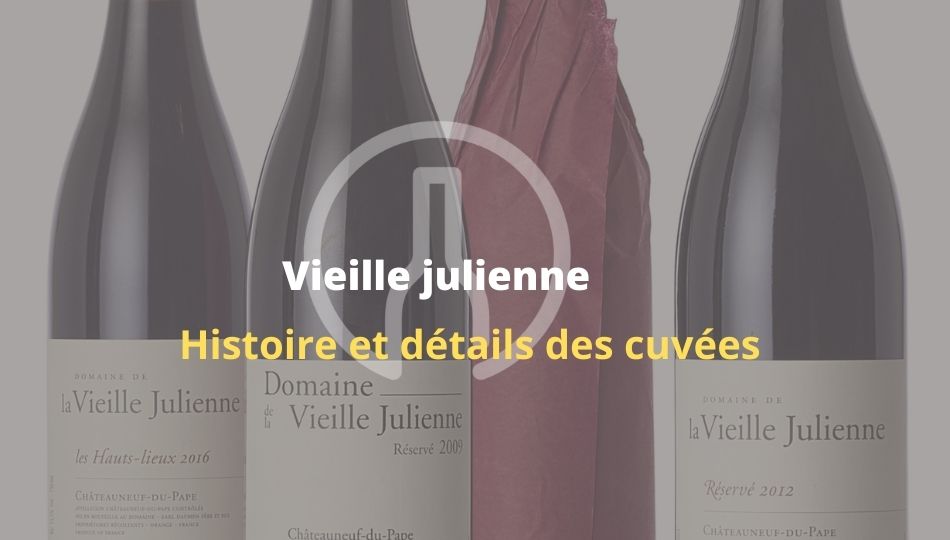Visit La Vielle Julienne estatewhich we're going to talk about today, will tell the story of Monsieur Daumen, who, without his purchase at the time, would not be what he is today. In this article, I'll describe the history of this estate, as well as the details of these three great cuvées.
History of the domain :
Mr Daumen acquires the Domaine de la Vieille Julienne in 1905. The winemaker cultivated a few plots of vines already planted on the Clavin site and carried out massal selections. The wine was then sold in bulk and to the trade, with only a few "house" cuvées intended for family and friends. Bottled sales began in the late 1960s. Maxime Daumen began renovating the winery at Domaine de la Vieille Julienne and acquired new barrels. Jean-Paul Daumen joined the domaine in 1990 and opted for ecological viticulture, with no treatments on the vines and minimal use of chemicals.
Jean-Paul Daumen efficiently manages this beautiful Châteauneuf-du-Pape. Thanks to remarkable work in the vines and a very natural approach to winemaking. His wines are classic, expressive and elegant. With enormous ageing potential, the house's two cuvées express the quintessence of old Grenache.
The estate's cuvées :
-
Châteauneuf du Pape reserved :
 The particularity of this cuvée is difficult to explain. But we can say that old vines, low yields and a natural approach are the foundations of this cuvée. But it's thanks to the microclimate of the northern part of Châteauneuf du Pape that it solidifies its character. In the words of Jean Paul Damen, "In mid-August, when the vineyard is deserted, I like to wander through the vines on the 'Trois Sources' slope, observing their expressions, tasting the berries. At that moment, I have to be receptive and appreciate all the details that mean that, in the context of certain vintages, certain vines show particular expressions. In this case only, these hundred-year-old vines of Grenache (90%), but also Syrah, Cinsault and Counoise will be identified and vinified separately to produce the Réservé." It's drunk exactly like the 3 sources and comes from the same terroir. But with a level of polish and purity in its tannins and fruit, this sensational cuvée gives layers of black raspberries, blueberries, crushed violets and black licorice. It's thick and creamy. This bottle is hard to find. It's one of the world's most singular and impressive wines.
The particularity of this cuvée is difficult to explain. But we can say that old vines, low yields and a natural approach are the foundations of this cuvée. But it's thanks to the microclimate of the northern part of Châteauneuf du Pape that it solidifies its character. In the words of Jean Paul Damen, "In mid-August, when the vineyard is deserted, I like to wander through the vines on the 'Trois Sources' slope, observing their expressions, tasting the berries. At that moment, I have to be receptive and appreciate all the details that mean that, in the context of certain vintages, certain vines show particular expressions. In this case only, these hundred-year-old vines of Grenache (90%), but also Syrah, Cinsault and Counoise will be identified and vinified separately to produce the Réservé." It's drunk exactly like the 3 sources and comes from the same terroir. But with a level of polish and purity in its tannins and fruit, this sensational cuvée gives layers of black raspberries, blueberries, crushed violets and black licorice. It's thick and creamy. This bottle is hard to find. It's one of the world's most singular and impressive wines.
-
Châteauneuf du Pape les trois sources :

Located on a slope between "Lieu-dit Clavin" and "les Hauts-lieux", the mosaic of safre sands and pebbles rich in red clay is particularly suited to Grenache, which expresses perfect power, balance and finesse. The vineyard covers 8.5 hectares and the average age of the vines is 75 years. The grape varieties used are: grenache noir, cinsault, syrah, counoise, mourvèdre, muscardin, terret noir, vaccarèse, grenache blanc bourboulenc, clairette and picardan. It's concentrated and voluptuous, with a huge mid-palate and soft tannins. Outstanding notes include black licorice, grilled herbs, black raspberries, blueberries and crushed flowers. Everything is balanced in this cuvée and its finish is endless. It can be cellared for 20 to 25 years.
-
Châteauneuf du Pape les hauts lieux :
 This is the highest and most frequented part of the slope. The marly soils and shallower safres are covered with quartzite pebbles and are much more suited to Mourvèdre. This is also the coolest and latest-growing part of the vineyard, and thanks to the tannins it supports, the wines are vigorous and elegant. The vineyard covers 4 hectares and the vines are 70 years old. It's made up of 80 % of Grenache and 20 % of Mourvèdre. It's straightforward, exuberant and offers more minerality, as well as plenty of ripe fruit, spice, roasted meats and hints of violets in a concentrated, backward and tannic style. This cuvée can be enjoyed over the next two decades.
This is the highest and most frequented part of the slope. The marly soils and shallower safres are covered with quartzite pebbles and are much more suited to Mourvèdre. This is also the coolest and latest-growing part of the vineyard, and thanks to the tannins it supports, the wines are vigorous and elegant. The vineyard covers 4 hectares and the vines are 70 years old. It's made up of 80 % of Grenache and 20 % of Mourvèdre. It's straightforward, exuberant and offers more minerality, as well as plenty of ripe fruit, spice, roasted meats and hints of violets in a concentrated, backward and tannic style. This cuvée can be enjoyed over the next two decades.
We hope you've enjoyed this article, and that it has helped you understand the history of the estate and the details of these cuvées. You can find our other articles on winegrowing estates here.





